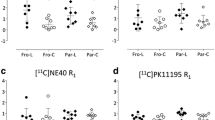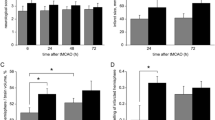Summary
1. Intracerebral injection of the oxidative metabolite of 1-methyl-4-phenyl-1,2,3,6-tetrahydropyridine (MPTP), 1-methyl-4-phenylpyridine (MPP+), into the substantia nigra of adult rats resulted in a lesion at the injection site.
2. Using autoradiography, we localized specific [125]CGP 42112 binding that was not recognized by angiostensin II or angiotensin II AT1 or AT2 receptorselective ligands.
3. Our results suggest that [125I]CGP 42112 may be binding to activated microglia that appear at the lesion site.
Similar content being viewed by others
References
Andersson, P.-B., Perry, V. H., and Gordon, S. (1991). The kinetics and morphological characteristics of the macrophage-microglial response to kainic acid-induced neuronal degeneration.Neuroscience 42:201–214.
Bottari, S. P., de Gasparo, M., Steckelings, U. M., and Levens, N. R. (1993). Angiotensin II receptor subtypes: Characterization, signalling mechanisms, and possible physiological implications.Front Neuroendocrinol. 14:123–171.
Burns, R. S., Chiueh, C. C., Markey, S. P., Ebert, M. H., Jacobowitz, D. M., and Kopin, I. J. (1983). A primate model of parkinsonism: Selective destruction of dopaminergic neurons in the pars compacta of the substantia nigra by 1-methyl-4-phenyl-1,2,3,6-tetrahydropyridine.Proc. Natl. Acad. Sci. USA 80:4546–4550.
Burns, R. S., LeWitt, P. A., Ebert, M. H., Pakkenberg, H., and Kopin, I. J. (1985). The clinical syndrome of striatal dopamine deficiency: Parkinsonism induced by 1-methyl-4-phenyl-1,2,3,6-tetrahydropyridine (MPTP).N. Engl. J. Med. 312:1418–1421.
Chiueh, C. C., Burns, R. S., Markey, S. P., Jacobowitz, D. M., and Kopin, I. J. (1985). Primate model of parkinsonism: Selective lesion of nigrostriatal neurons by 1-methyl-4-phenyl-1,2,3,6-tetrahydropyridine produces an extrapyramidal syndrome in rhesus monkeys.Life Sci. 36:213–218.
Davis, G. C., Williams, A. C., Markey, S. P., Ebert, M. H., Caine, E. D., Reichert, C. M., and Kopin, I. J. (1979). Chronic parkinsonism secondary to intravenous injection of meperidine analogues.Psychiat. Res. 1:249–254.
Giulian, D. (1993). Reactive glia as rivals in regulating neuronal survival.Glia 7:102–110.
Giulian, D., and Baker, T. J. (1985). Peptides released from ameboid microglia regulate astroglial proliferation.J. Cell Biol. 101:2411–2415.
Giulian, D., and Robertson, C. (1990). Inhibition of mononuclear phagocytes reduces ischemic injury in the spinal cord.Ann. Neurol. 27:33–42.
Giulian, D., Woodward, J., Krebs, J. F., and Lachman, L. B. (1988). Intracerebral injections of interleukin-1 stimulates astrogliosis and neovascularization.J. Neurosci. 8:2485–2490.
Giulian, D., Chen, J., Ingeman, J. E., George, J. K., and Noponen, M. (1989). The role of mononuclear phagocytes in wound healing after traumatic injury to adult mammalian brain.J. Neurosci. 9:4416–4429.
Heemskerk, F. M. J., Zorad, S., Seltzer, A., and Saavedra, J. M. (1993). Characterization of brain angiotensin II AT2 receptor subtype using [125I]CGP 42112A.Neuroreport 4:103–105.
Jenner, P., Marsden, C. D., Costall, B., and Naylor, R. J. (1986). MPTP and MPP+-induced neurotoxicity in rodents and the common marmoset as experimental models for investigation of Parkinson's disease. In Markey, S. P., Castagnoli, N., Jr., Trevor, A. J., and Kopin, I. J. (eds.),MPTP: A Neurotoxin Producing a Parkinsonian Syndrome, Academic Press, New York, pp. 45–68.
Kimura, B., Sumners, C., and Phillips, M. I. (1992). Changes in skin angiotensin II receptors in rats during wound healing.Biochem. Biophys. Res. Commun. 187:1083–1090.
Langston, J. W., Ballard, P., Tetrud, J. W., and Irwin, I. J. (1983). Chronic parkinsonism in humans due to a product of meperidine analog synthesis.Science 219:979–980.
Langston, J. W., Irwin, I., Langston, E. B., and Forno, L. S. (1984). Pargyline prevents MPTP-induced parkinsonism in primates.Science 225:1480–1482.
Lee, W.-H., Clemens, J. A., and Bondy, C. A. (1992). Insulin-like growth factors in the response to cerebral ischemia.Mol. Cell. Neurosci. 3:36–43.
Liang, S.-M., Liang, C.-M., and Chiueh, C. C. (1989). Visualization of interleukin-2-like molecules in MPP+-lesioned rat brain.Biochem. Biophys. Res. Commun. 165:1312–1318.
Paxinos, G., and Watson, C. (1982).The Rat Brain in Stereotaxic Coordinates, Academic Press, New York.
Perry, V. H., and Gordon, S. (1991). Macrophages and the nervous system.Int. Rev. Cytol. 125:203–244.
Saavedra, J. M. (1992). Brain and pituitary angiotensin.Endocrine Rev. 13:329–380.
Timmermans, P. B. M. W. M., Wong, P. C., Chiu, A. T., Herblin, W. F., Benfield, P., Carini, D. J., Lee, R. J., Wexler, R. R., Saye, J. A. M., and Smith, R. D. (1993). Angiotensin II receptors and angiotensin II receptor antagonists.Pharmacol. Rev. 45:205–251.
Viswanathan, M., and Saavedra, J. M. (1992). Expression of angiotensin II AT2 receptors in the rat skin during experimental wound healing.Peptides 13:783–786.
Viswanathan, M., and Saavedra, J. M. (1993). Angiotensin II receptor subtypes and growth. InAngiotensin Receptors (J. M. Saavedra and P. B. M. W. M. Timmermans, Eds.), Plenum Press, New York (in press).
Viswanathan, M., Strömberg, C., Seltzer, A., and Saavedra, J. M. (1992). Balloon angioplasty enhances the expression of angiotensin II AT1 receptors in neointima of rat aorta.J. Clin. Invest. 90:1707–1712.
Whitebread, S. E., Taylor, V., Bottari, S. P., Kamber, B., and de Gasparo, M. (1991). Radioiodinated CGP 42112A: A novel high affinity and highly selective ligand for the characterization of angiotensin AT2 receptors.Biochem. Biophys. Res. Commun. 181:1365–1371.
Author information
Authors and Affiliations
Rights and permissions
About this article
Cite this article
Viswanathan, M., de Oliverira, A.M., Wu, R.M. et al. [125I]CGP 42112 reveals a non-angiotensin II binding site in 1-methyl-4-phenylpyridine (MPP+)-induced brain injury. Cell Mol Neurobiol 14, 99–104 (1994). https://doi.org/10.1007/BF02088592
Received:
Accepted:
Issue Date:
DOI: https://doi.org/10.1007/BF02088592




